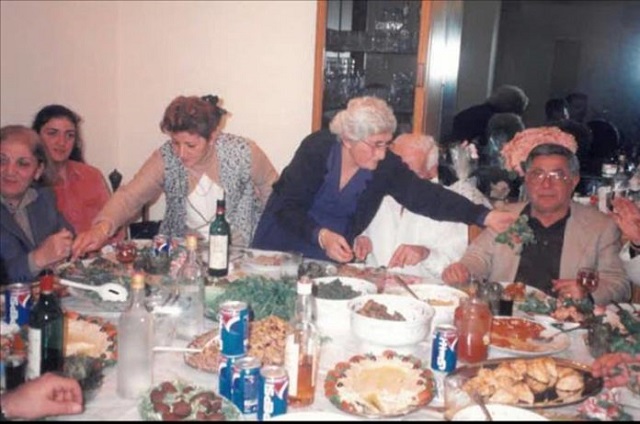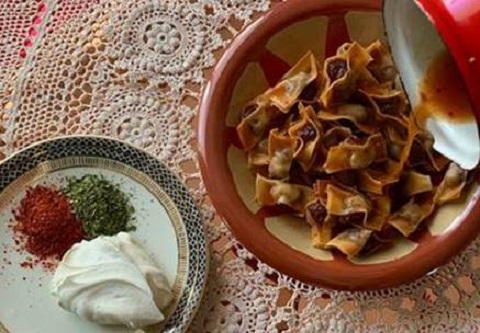LOS ANGELES — A first-generation American side hustle becomes a path for generational bonding and war relief efforts.
Story by Lara Talatinian as told to Kirsten Judson. Originally published on Zagat Stories.
Born and raised in Los Angeles, Lara Talatinian is a first-generation Armenian-American. She is an event specialist and graduated from California State University, Northridge. She created Call for a Good Thyme as a way to bring Armenian cuisine to the table, support mutual aid, and preserve her family’s legacy.Call for a Good Thyme is a multifaceted events company focusing on cultivating community through food, party and culture. It specializes in charcuterie and cheese platters, floral design and party planning.
From Lara Talatinian:
Generational cooking has played an important role in my life. I think about my grandparents, my grandmothers, both maternal and paternal, and I reflect on how each one had a different style, and how I would only eat certain things they would make.
One of my grandmothers lives in Toronto, and her apartment always smelled like manakish, which is basically just za’atar bread. She would make it at home all the time — I thought that was the coolest thing. I’d wake up in her apartment on the pullout couch and have manakish and tea. It was the definition of comfort.
My other grandmother in Los Angeles was an incredible chef, but the thing I enjoyed the most from her was simple — toasted pita bread, turned around a few times on the stovetop, a little crunch but still soft, along with some black tea with cloves and cinnamon sticks. We got to choose how many teaspoons of sugar we wanted. These experiences were a way for both of my grandparents to pass tradition along. Kids are picky eaters, and I was by far the pickiest. These simple, warm, bready treats brought comfort to me anytime I needed it.
I have the image in my head of my house in 1994, before we remodeled. The kitchen was small with white tiles. I had a stool I would put against the counter when my mom and I would wake up early to make mantuh. Mantuh is every kids favorite—crunchy little beef dumplings wrapped in dough. The aroma takes over the entire house when it’s baking.”
In my opinion, mantuh’s not like a dumpling. It doesn’t have certain creases you need to work with, and it’s a lot more delicate. Traditionally you knead the dough and roll it out thin, then cut them into small squares. The meat goes on top, and you pinch two sides together to resemble a bowtie. My mother and I took the easy route, using wonton wrappers instead of making our own dough.
She worked long hours and did not play around with difficult dishes—rather, she made things that were simple, traditional, and nutritious. To make mantuh for her was a big feat, and having my brother and myself by her side to help was the only way we were going to get to eat it — to put work into it. It was a great life lesson, being able to work together for a common cause.
Making mantuh is so tedious, and one really needs help doing it. My mom would always praise my talents. Over the years, it became my favorite thing to do in the kitchen because I couldn’t wait to eat it, and I was good at making it. When I got to college, I would make mantuh for my friends. It was always a big event. I would have people over, and we would cook together. Making mantuh is a collaborative process—it’s not difficult, but you definitely feel like you are making something.
I grew up eating Armenian comfort food and learned generational recipes that were passed down. My grandmother’s recipes sustained my relationship to my family’s history—something not discussed much in our household. Through cooking, my senses were able to preserve culture and family, and give me insight into a world I was brought up in, but ultimately was able to make my own.
Some years ago, I worked for a tech company. They hosted events and dinners for clients and had giant meetings. Over time, they trusted me doing the food, and I began to curate these events. This was the fun part of the job. I always assumed I was good at it, or else someone else would be doing it. I really thought of it as me doing the hosting, in a way.
I come from a background where we always anticipate what other people’s needs are. In my culture—Armenian, from Lebanon—one must always be nourished. We are constantly reminded that we need to take care of one another. This cultural understanding trickled down to my hosting skills when I was at the tech company. I tried to take special diets into consideration when planning the menu. At the time, a lot of people were on the keto diet, so I started to order a lot of Armenian or Lebanese food because it was keto-friendly.
As soon as I incorporated cuisine close to my heart, I became fascinated with the world of hosting. We would have bartenders come make drinks, and I would go behind the bar and get my hands dirty. I would help in the kitchen. I liked watching the whole process. I would plate things, do the dishes, and also play with prosciutto. And this was very fun. That aspect of the job is what made me love it so much. When I left that job, I thought, I guess I could host in this capacity outside of this specific environment. That’s when Call for a Good Thyme was born.
Call for Good Thyme is a way to express my culinary aesthetic and unique way of presenting. My style became “tables of wonderment,” or what I like to call “an adult snack table.” I believe that food needs to be presentable. This facet of my aesthetic comes from my culture—everything needs to be aesthetically pleasing, and the more the better. It’s got to be in the right dish, in the correct color. You have to have everything on the table, which is why our Armenian and Middle Eastern tables are filled to the brim.
I work in colors and textures, making sure I include the high- and lowbrow snacking needs of my clientele. I want my tables to feel approachable. I want people to flirt with each other over the table, discuss ingredients with the person across from you. Food should be a shared experience, and for what it’s worth I think we all miss that aspect of sharing meals with those we know, or want to get to know better.
I started creating Mantuh-2-Go kits 10 days before the war in Nagorno-Karabakh started. After we got word of the war, I began donating 100 percent of proceeds to the Armenia Fund in October and November, while reaching out to people on social media to let them know that Armenians need their help in getting recognition for the atrocities being committed on civilians in the Artsakh area.
The way the community came together was tremendous, and the only way I knew how to contribute was with the kits. After we lost some of the lands in the Artsakh region, and a treaty was signed to stop the war, I felt it was a good time to stop working on the kits and start trying to understand what happened—where we went wrong, what else we could have done, and where my next steps were taking me.
So many different stages and phases of the war were discussed in the doorway of my apartment. Friends and strangers alike—those wanting to support in any way they can—found solace in
being able to say hello and speak about the emotional hardships we were dealing with due to the war. Food won’t make anyone forget that people halfway around the world are suffering, but it can be of some momentary comfort. Bringing culture out of the kitchen has always been my goal, and being able to sell my kits to those who wanted to help was the best way to manifest that for me.
I feel like food, cultural assimilation, and identity are so connected—it’s this kind of subconscious thing. As an Armenian, when you are a people who has a direct ties to generational trauma—especially after what’s been happening, and what’s happened in the last few months—you cling to whatever you can that brings you comfort. And a lot of times what brings you comfort is the food you eat and make. It’s being able to see each other and say, “Hey, how are you doing? Do you want to share a meal?” Sharing a moment of indulgence can create a space that is devoid of that pain and trauma.
Main Photo Caption: Lara Talatinian’s grandmother Keghanoush Artinian (center, in blue) at a family meal in Beirut, Lebanon, in 2000. Photo: Courtesy Lara Talatinian.

























































